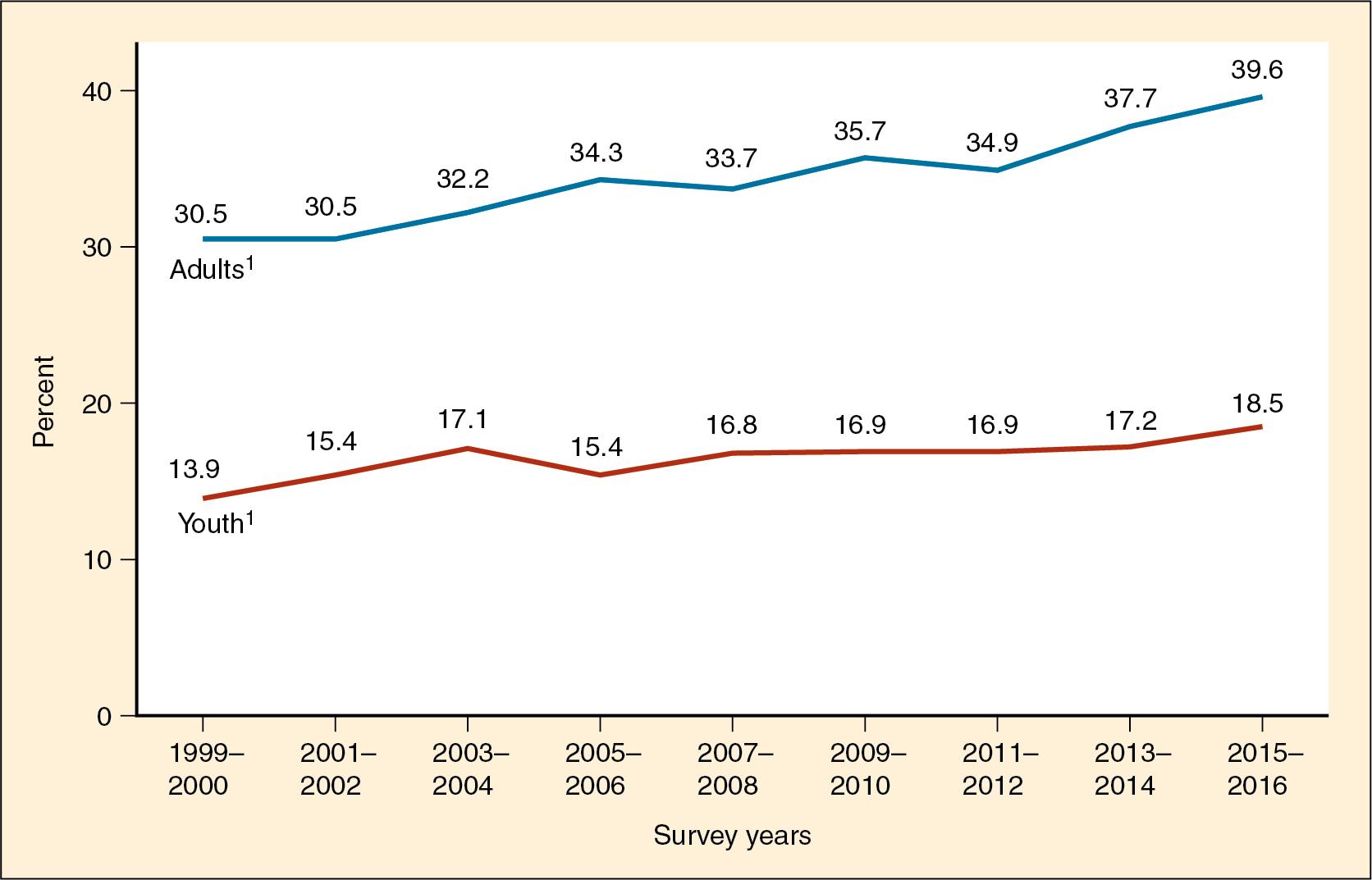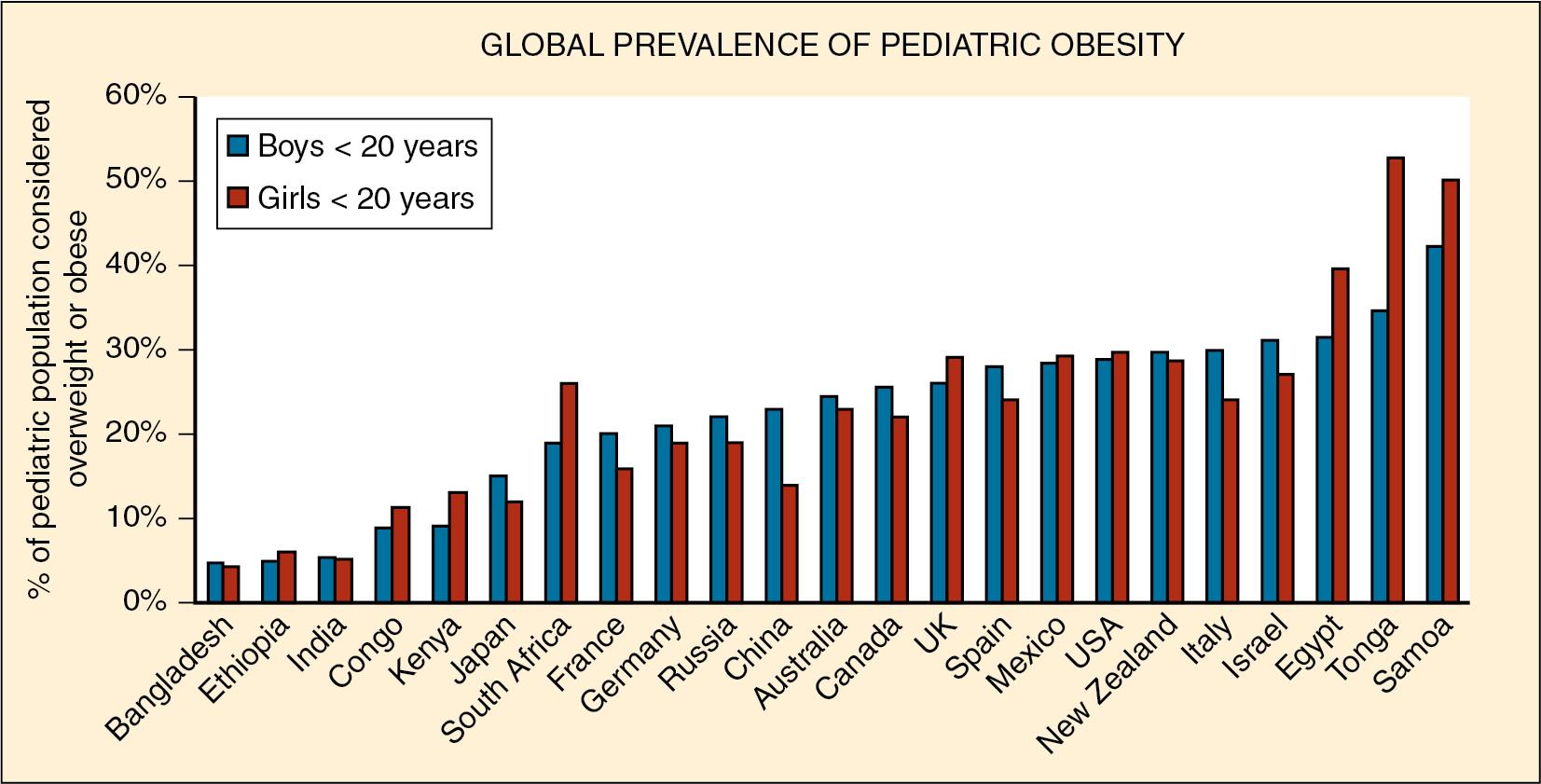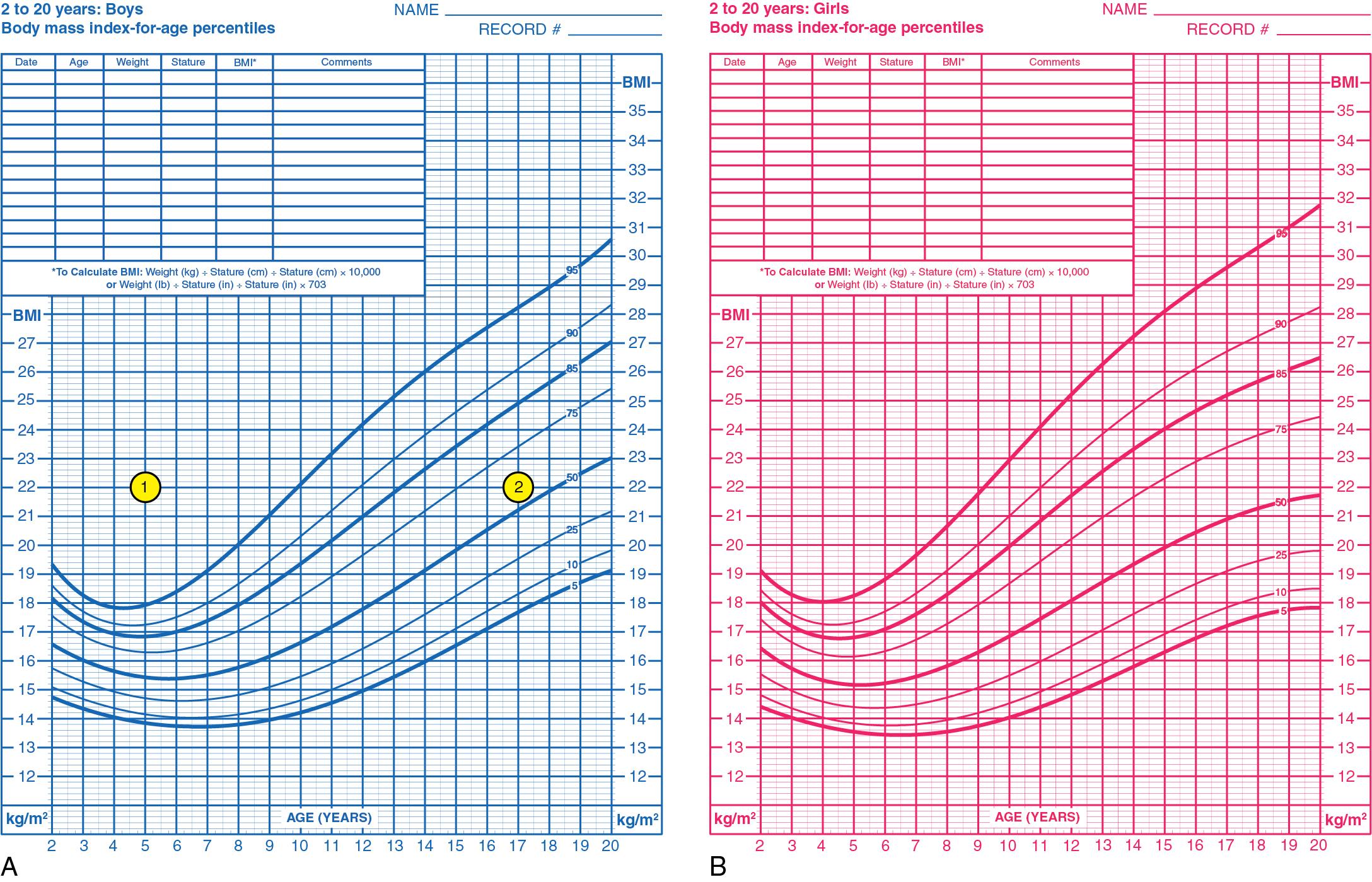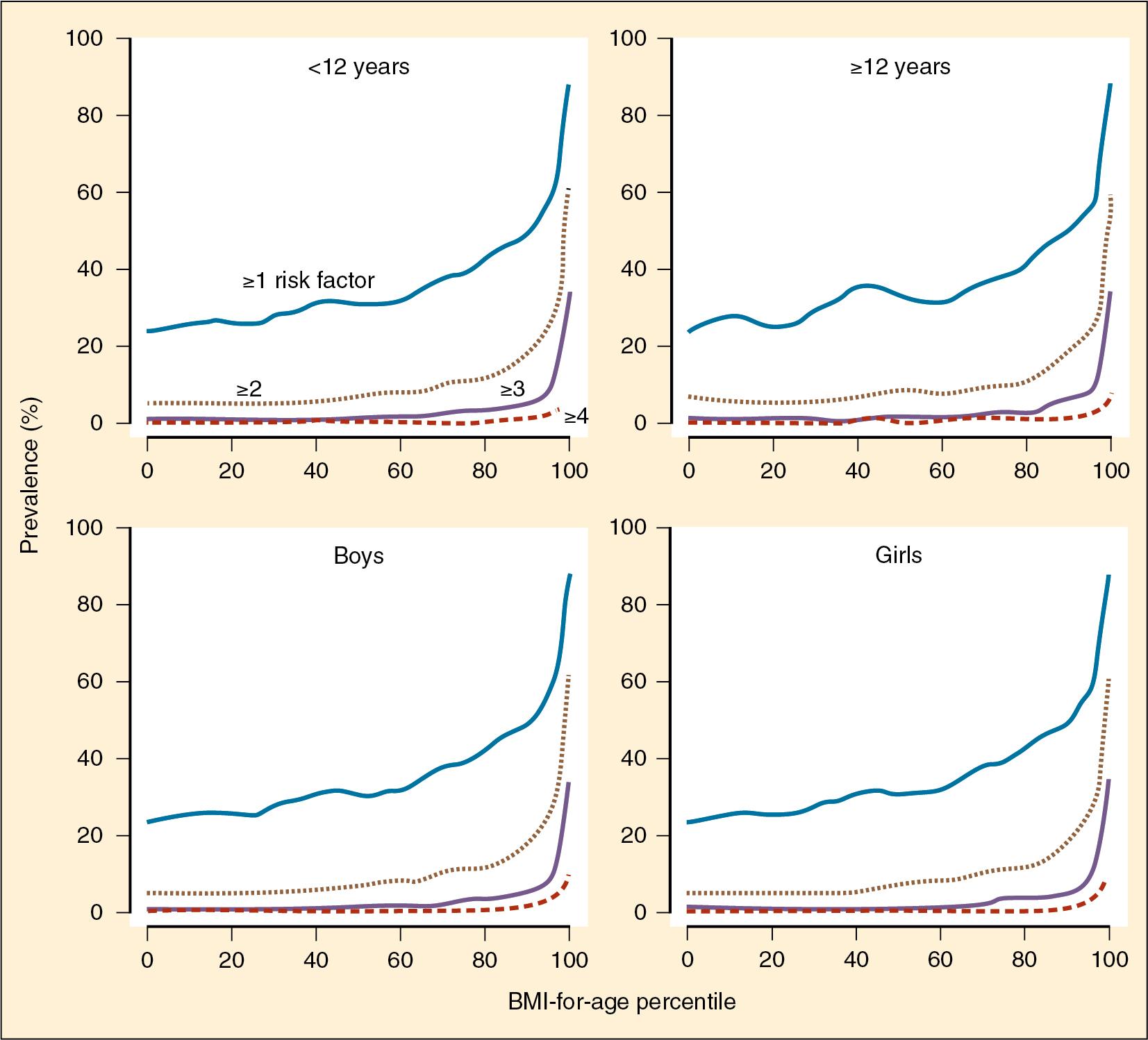Physical Address
304 North Cardinal St.
Dorchester Center, MA 02124
The dramatic rise in pediatric obesity has made it a common consideration for the pediatric anesthesiologist and surgeon. For the first time in human history, obesity now rivals malnutrition as the most life threatening global disorder among children ( ). According to a 2016 estimate from the World Health Organization (WHO), worldwide obesity has tripled since 1975. Nearly 41 million children under the age of 5 and 340 million children and adolescents aged 5 to 19 are overweight or obese worldwide. The rise in frequency of obese children presenting to our operating rooms, intensive care units, and pain clinics is creating new challenges to our profession. This chapter investigates these challenges, with a focus on (1) the best practices for measuring pediatric obesity; (2) obesity’s effect on child health; (3) how obesity influences pediatric perioperative anesthesia care; and (4) the role of bariatric surgery in severe adolescent obesity.
Obesity in the United States has become a public health issue as the prevalence of obesity has risen over the last several decades ( Fig. 53.1 ). American youth experienced a tripling of obesity rates between the 1960s and early 2000s. In the United States the prevalence of obesity among youth aged 2 to 19 years is now about 18%; 6% of American kids are severely obese ( ). Substantial increases in pediatric obesity rates have also occurred in many other parts of the world as our global community becomes increasingly affluent and urbanized. For example, in 2013, China (a country with historically low rates of obesity) became the nation with the second-largest population of obese citizens after the United States ( ). The global prevalence of overweight and obese children and adolescents has risen from 4% in 1975 to over 18% in 2016 (WHO Factsheet 2016). Fig. 53.2 illustrates the global prevalence of pediatric obesity. Although earlier studies suggested that the increase in prevalence of pediatric obesity had leveled off in the United States ( ), have found no evidence of decline in obesity prevalence at any age. In fact, they found that among children aged 2 to 5 years there was a significant increase in severe obesity from 2013 to 2016. Pediatric obesity remains a significant global public health issue and has lasting consequences to overall population health because many obese adolescents go on to become obese adults ( ).


A variety of descriptive obesity metrics, including absolute weight, weight-for-height percentiles, thickness of the triceps skinfold, percentage above ideal body weight, percentage of excess body weight, and waist circumference-to-height ratio have been described. These methods have been largely replaced by the body mass index (BMI), defined as weight in kilograms divided by height in meters squared: BMI = wt(kg)/ht(m) 2 . BMI has become the most commonly used metric of adult obesity because of its ease of measurement and its correlation with overall adiposity ( ). Although BMI is a valuable tool in adults, its use in the pediatric population is problematic because of the nonlinear relationship between BMI and age for the age range of 2 to 20 years. This curvilinear relationship is depicted in Fig. 53.3 A and B. BMI approaches its nadir at approximately 5 years of age and then rises steadily throughout later childhood and adolescence. To account for the wide developmental variation among children, BMI must be converted to a BMI percentile in which the BMI is compared with a population of children of similar age and gender. The U.S. Centers for Disease Control (CDC) created weight status categories for children along the BMI-percentile continuum, listed in Table 53.1 . Consider a 5-year-old and a 15-year-old male with a common BMI of 22. The 5-year-old ( Fig. 53.3 A, point 1) is well above the 95th percentile and would be characterized as obese by CDC criteria, whereas the 15-year-old with the identical BMI ( Fig. 53.3 A, point 2) would fall into the 50th percentile, a healthy weight. The CDC categories represent one of many approaches to the characterization of pediatric obesity. The American Heart Association defined severe obesity in children older than 2 years as the lower of the following two metrics: a BMI of ≥120% of the 95th percentile or an absolute BMI of ≥35 kg/m 2 ( ). Other groups, such as the International Task Force on Obesity ( ) and the World Health Organization ( ), have created other statistical tools with somewhat different pediatric obesity cutoffs. The development of a common language describing pediatric obesity will be critical to tracking future obesity trends and evaluating new treatment modalities.

| Percentile Ranking | Weight Status |
|---|---|
| Less than 5th percentile | Underweight |
| 5th percentile to less than 85th percentile | Healthy weight |
| 85th percentile to less than 95th percentile | Overweight |
| Equal to or greater than the 95th percentile | Obese |
Children in the uppermost BMI percentiles are of special concern to healthcare providers. As the pediatric population has become increasingly overweight, investigators have documented a rightward shift of obesity curves, resulting in approximately 6% of U.S. children with severe obesity ( ). These children merit special consideration in the perioperative setting. demonstrated that the probability of cardiovascular or metabolic disease rises dramatically at this threshold. Their longitudinal analysis examined specific risk factors, including hypertension, dyslipidemia, and insulin resistance in children between the ages of 5 and 17 years. As seen in Fig. 53.4 , among children with a BMI in the 95th percentile or higher, risk of having one, two, or three underlying disease risk factors increased to 84%, 59%, and 33%, respectively. Data from Kelly and colleagues demonstrates that youth with severe obesity also show early signs of vascular dysfunction and subclinical atherosclerosis ( ). Cincinnati Children’s Hospital has adopted the 99th percentile as an indicator of “high-risk” obesity because of the elevated probability of underlying disease in this patient population. Those BMIs corresponding to the 99th percentile for age and gender can be found in Table 53.2 . Children in this subgroup should undergo an extensive preoperative evaluation of comorbidities and surveillance after anesthesia or sedation. Children above the 99th percentile are prohibited from having a general anesthetic in our ambulatory surgery center, where potential postoperative admission capabilities are limited.

| Age (yrs) | Boys (BMI) | Girls (BMI) |
|---|---|---|
| 5 | 20.1 | 21.5 |
| 6 | 21.6 | 23 |
| 7 | 23.6 | 24.6 |
| 8 | 25.6 | 26.4 |
| 9 | 27.6 | 28.2 |
| 10 | 29.3 | 29.9 |
| 11 | 30.7 | 31.5 |
| 12 | 31.8 | 33.1 |
| 13 | 32.6 | 34.6 |
| 14 | 33.2 | 36 |
| 15 | 33.6 | 37.5 |
| 16 | 33.9 | 39.1 |
| 17 | 34.4 | 40.8 |
The health risks associated with obesity in children received little attention a generation ago. We now recognize that many obesity-related diseases, including hypertension, dyslipidemia, fatty liver disease, diabetes, obstructive sleep apnea, and polycystic ovarian disease can be present in childhood ( Box 53.1 ). Furthermore, the likelihood that a child will develop these diseases increases as the severity and longevity of obesity rise. Just as we refer to “pack-years” when describing the health risks associated with tobacco use over time, we now consider “pound years” when describing the temporal relationship between obesity and disease risk. Some diseases, such as diabetes, are strongly associated with duration of obesity ( ).
| Respiratory | Asthma |
| Upper respiratory infection | |
| Obstructive sleep apnea | |
| Cardiovascular | Hypertension |
| Left ventricular hypertrophy | |
| Endocrine | Metabolic syndrome |
| Dyslipidemia | |
| Polycystic ovarian syndrome | |
| Gastrointestinal | Reflux |
| Steatosis hepatitis | |
| Hepatic fibrosis | |
| Neurologic | Pseudotumor cerebri |
| Psychological | Low self-esteem |
| Orthopedic | Slipped capital epiphysis |
Epidemiologic data indicate that adult obesity commonly begins in childhood and is correlated with both the age of onset and the magnitude of childhood obesity. Among participants in the Bogalusa Heart study, a long-term community-based analysis of cardiovascular risk, every child in his or her early teens above the 99th percentile became an obese adult, and 65% became morbidly obese ( ). This phenomenon, known as “obesity tracking,” is also common among younger children. Cunningham demonstrated that two-thirds of children who were obese at some point between the ages of 5 to 9 demonstrated “entrenched obesity,” defined as remaining obese into early adolescence ( ). The observation that obesity in children has a high probability of tracking into adulthood has prompted many healthcare providers to advocate for early intervention, before significant comorbidities have time to develop.
The link between adult obesity and respiratory disease is well established. Pulmonary function testing in obese adults reveals a restrictive pattern with diminished functional residual capacity (FRC) and forced vital capacity ( ). These abnormalities are exacerbated in the supine position ( ), predisposing obese adults to ventilation-perfusion mismatch and hypoxemia. There is limited research investigating the relationship between pediatric obesity and pulmonary function. Excess adiposity lowers FRC and FEV 1 in children, but these changes are better correlated with weight as measured by bioelectrical impedance than with BMI ( ; ). Furthermore, there may be gender differences in obesity-related pediatric respiratory function that are poorly characterized ( ). Children with less severe forms of obesity have minimal perturbation of their pulmonary function ( ). Several studies have identified a weak link between asthma and pediatric obesity ( ; ). This relationship is poorly understood, as investigators have not yet determined whether the proinflammatory nature of obesity directly causes asthma or if exercise intolerance associated with asthma exacerbates obesity.
As association between obstructive sleep apnea (OSA) and pediatric obesity has been demonstrated by numerous studies. A cross-sectional study showed that children between the ages of 7 to 18 had an OSA prevalence of 44.6% in the obese group compared with 9.1% in the normal weight group ( ). In adolescents referred for bariatric surgery, OSA rates rise as BMI percentiles increase, approaching 50% in the heaviest cohort ( ). Airway obstruction secondary to adenotonsillar hypertrophy is a common finding in obese children ( ) and is a frequent indication for tonsillectomy and adenoidectomy (T/A). There is evidence that surgical success in this setting is dependent on weight status. Mitchell compared surgical outcomes in obese and nonobese children undergoing T/A. He determined that the incidence of mild, moderate, and severe OSA after surgery in the normal-weight cohort was 18%, 10%, and 0%, respectively. By contrast, postoperative outcomes in obese children were poorer, with incidences of 46%, 15%, and 15%, respectively ( ). A meta-analysis supports this finding, demonstrating that obstructive sleep apnea persisted after surgical intervention in 51% to 66% of overweight and obese children ( ).
Many of the pathologic cardiovascular findings in obese adults are also recognized in obese children, including the risk for hypertension, atherosclerosis, arterial stiffness, and left ventricular hypertrophy. The prevalence of hypertension in the United States is much higher in obese children (up to 25%) compared with the estimated 3% to 5% in the general pediatric population ( ). Despite its common association with obesity, the pathogenesis of obesity-related hypertension is not well understood ( ). Investigators have observed that arterial plaque formation can begin in childhood and that risk factors for acceleration of plaque deposition, including hypertension and obesity, are shared by both children and adults ( ). Ultrasound measurements of arterial stiffness support a relationship between childhood obesity and early vasculopathy. Measurements of carotid intima-media thickening (cIMT), a marker for atherosclerosis, are already elevated in obese school-age children ( ). CIMT has been shown to correlate with future cardiovascular events including myocardial infarction ( ). An analysis from the International Childhood Cardiovascular Cohort (i3c) consortium showed that obesity is the strongest risk factor for the development of an elevated cIMT, increasing that risk by almost four-fold ( ). An increase in fat mass will over time lead to an increase in total blood volume, stroke volume, cardiac output, systemic vascular resistance, and afterload. This change in cardiovascular physiology may lead to increased left ventricular mass and left ventricular concentric hypertrophy ( ). Severe obesity in adolescents is associated with an increase in left ventricular mass ( ), an independent predictor of adult cardiovascular morbidity ( ). There is strong evidence that obesity-related alterations in myocardial architecture are reversible with weight loss, providing a compelling argument for aggressive management of teens with significant obesity ( ).
Many musculoskeletal diseases are associated with pediatric obesity, including Blount’s disease, degenerative joint disease, and slipped capital femoral epiphysis (SCFE). Blount’s disease causes progressive lower extremity deformity, leg length discrepancy, and early knee arthritis. In a study of 890 obese children with a mean BMI of 35 kg/m 2 , increasing BMI was associated with higher risk of Blount’s disease ( ). The relationship between obesity and SCFE is well described. Eighty percent of patients with SCFE have a BMI above the 95th percentile, and the incidence of bilateral disease is highest in the heaviest adolescents ( ). Many of these skeletal disorders require surgical intervention and represent important nonbariatric indications for anesthesia care among obese youth.
Obese children have a characteristic constellation of metabolic diseases. Type 2 diabetes (T2DM), traditionally a disease of obese adults, is increasingly recognized in obese youth ( ). Obesity is the most common comorbidity associated with type 2 diabetes in youth ( ). Prediabetes, including hyperinsulinemia, insulin resistance, and impaired glucose tolerance, is also common in obese children. In a study of over 700 obese youth of European descent, impaired glucose homeostasis was identified in 20% to 25% of obese subjects ( ). The metabolic syndrome, a clustering of specific cardiometabolic risk factors, including glucose intolerance and hypertension, is strongly associated with pediatric obesity ( ). Polycystic ovarian syndrome (PCOS) represents another pediatric obesity-related endocrinopathy. Although PCOS occurs in approximately 10% of all women, 50% of women with PCOS are overweight ( ). In adults, bariatric surgery (Roux-en-Y or sleeve gastrectomy) combined with medical therapy, was more effective than medical therapy alone in reducing weight and providing glycemic control ( ). A study by Inge and colleagues demonstrated that 86% of obese adolescents with diabetes who underwent bariatric surgery achieved continued remission of diabetes 5 years after surgery. In total, 88% of obese adolescents with diabetes enrolled in this study received medications for diabetes preoperatively; this percentage decreased to zero by the end of the 5-year study ( ).
Gastrointestinal maladies, including reflux, gallstones, and liver pathology, are commonly found in obese youth. A broad continuum of hepatic diseases is associated with morbid obesity in both childhood and adulthood ( ). Nonalcoholic fatty liver disease (NAFLD) occurs secondary to fatty accumulation within the liver. Mild hepatic changes, known as steatosis, describe a benign and nonprogressive accumulation of hepatic fat. The more severe form, nonalcoholic steatohepatitis (NASH), is associated with fibrosis, hepatic inflammation, and elevated transaminases. A meta-analysis conducted by Anderson and colleagues found that the prevalence of NAFLD is approximately 7% in nonobese children and up to 34% in obese children ( ). Hepatic cirrhosis has occurred in children with NASH as young as age 10 years ( ). Weight loss is the primary treatment recommendation for NAFLD in guidelines from the North American Society for Pediatric Gastroenterology, Hepatology and Nutrition ( ). Bariatric surgery may be useful for adolescents with severe obesity but the evidence for bariatric surgery in improving NAFLD in children remains limited ( ). Currently, there are no medications recommended for routine treatment of NAFLD in children.
The association between pediatric obesity and pseudotumor cerebri is well described ( ). Evidence also suggests a potential link between adolescent obesity in girls and the risk of, and morbidity from, multiple sclerosis ( ). Perhaps most distressing is the profound psychosocial effect of severe pediatric obesity. Eisenberg and colleagues have shown that adolescents who reported weight-based teasing among family members and peers were found to have low body satisfaction, low self-esteem, highly depressive symptoms, and suicidality. These associations were present in all gender, racial, ethnic, and weight groups ( ). Obese adolescents suffer from high rates of depression, although it is unclear if the propensity for affective disease predates their obesity or results from it. Among patients presenting to one bariatric surgery program, 30% met criteria for clinically significant depression when based on self-report; this rose to 45% when based on parental input ( ). There is also evidence that obesity contributes to the diminution of economic opportunities such as household income ( ). Investigation of health-related quality of life has demonstrated that obese adolescents score significantly lower than their healthy-weight peers. Research using these measurements suggests that the emotional effect of severe obesity is indistinguishable from that of cancer ( ).
Become a Clinical Tree membership for Full access and enjoy Unlimited articles
If you are a member. Log in here